
“What defines a person is how well they rise after falling.”
Meet Hannah. We went to India together about a decade ago. We often used the phrase “HAVE TRUST” when we experienced the fear of traveling around a territory unknown to us. We also used an immense amount of humor when things failed to work out as intended. We practiced the principals of yoga and studied ancient scriptures, such as the “Bhagavad Gita” together. Our only purpose was to learn as much as we could about living a more fulfilled life before returning home. And India taught us just that.
Applying Lessons From The Bhagavad Gita In Modern Times:
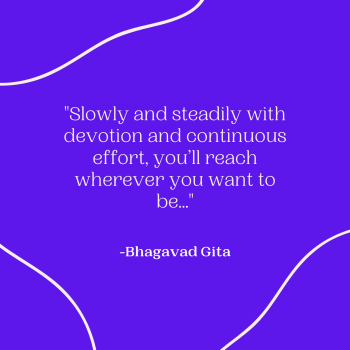
There are numerous teachings on how to implement the various practices of yoga. A yoga student can easily receive instruction on physical postures, breathwork, and meditation techniques; however, there is minimal direction on how to translate the practice of yoga into our lives off the mat. The Bhagavad Gita is one significant text from the yoga tradition that teaches an individual how to apply yoga principles to all aspects of life. The Gita is a story that anyone can access. It provides practical knowledge on how to live skillfully and with a sense of greater purpose.
The Gita is one of the most revered scriptures in India. It is also one of the most widely translated and read texts in the world. This written piece of work inspired Gandhi himself. Gandhi wrote, “When doubts haunt me and disappointments stare me in the face, and I see not one ray of hope on the horizon, I turn to the Gita and find a verse to comfort me; I immediately begin to smile in the midst of overwhelming sorrow.”
Central Themes In The Bhagavad Gita
The Three Central Themes Include:
- Dharma
- Right Action
- Non-Attachment
The text is less about yoga’s methodologies and more about what these practices are supposed to lead us toward. The Gita is a tale about one’s Dharma (moral duty or purpose), proper action (karma), and non-attachment. It is also a lesson on the true nature of the Self (Atman) and the human condition.
The Battle Of The Mind:
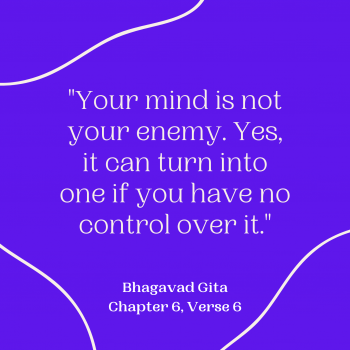
The Gita does not take place on a yoga mat. Instead, it takes place on a battlefield. The turbulent setting represents the battle of life. In many ways, life is a battle filled with endless challenges to overcome. One of these challenges is the mind.
All-day, the mind generates thoughts, which can be helpful or destructive. The purpose of yoga is to come to a clear, calm, and tranquil mind, so we can then answer some of life’s most commonly asked questions. I know I respond much differently to these questions when I feel an openness to possibilities rather than fearful of them. Understanding ourselves lets us observe what may be holding us back from living a more purposeful life. With this knowledge, we can then take appropriate actions to keep moving toward the things that give our life meaning.
The Purpose of Purpose:
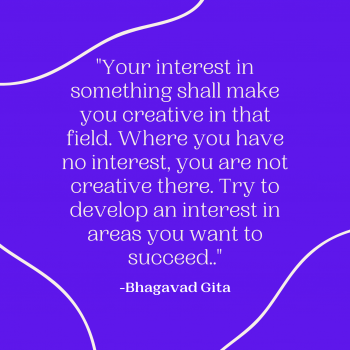
One of life’s most common questions is, “What is the purpose of life?” Without purpose, we fall short of direction, joy, and contentment. A key concept in the Gita is a word called Dharma, which translates as purpose. Dharma is often associated with passion. Our passions bring us joy. When you use this joy or passion in the services of others, this is purpose.
Think about a teacher you had that you did not learn much from. What was this teacher like? Then think about a teacher that made a profound difference in your life. What was this teacher like? Both people had the same vocation. The only difference is one most likely had an interest or meaningful purpose for sharing knowledge with others, while the other did not. It matters less of what you are doing, but rather who you are being. Your Dharma is not necessarily your vocation but instead finding what gives you joy and then sharing that with others.
According to Rod Stryker, “We are each a single cell in the greater body of the world, with a unique role to play in the service of sustaining and advancing the world in which we are a part.” Can you imagine what the world would be like if we all believed we had a unique role to play during our time here? Not only that but that this role would have a profound impact on the world as a whole. Believing your life has purpose has the power to increase the quality of your life and, in turn, the quality of those around you.
What Does Yoga Have To Do With Life Purpose?
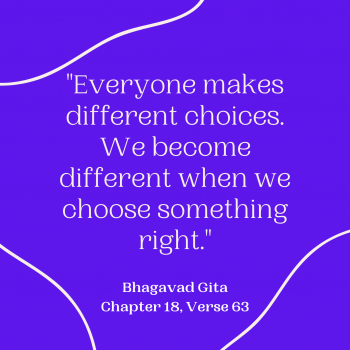
The purpose of practicing yoga is to know how to respond when not doing yoga. The Gita advises the practitioner to choose our actions carefully. Some of the choices we make give our life meaning, while others can lead to false pleasure, unfulfillment, and confusion. Increasing our awareness about our thoughts and beliefs is one way to make better choices.
Psychology has uncovered numerous ways in which our beliefs affect our behaviors and success in the world. Our beliefs are a powerful indicator of how we will choose to live our life. Therefore, we need to train our minds to question our beliefs to help better direct our lives.
The Purpose of Non-Attachment
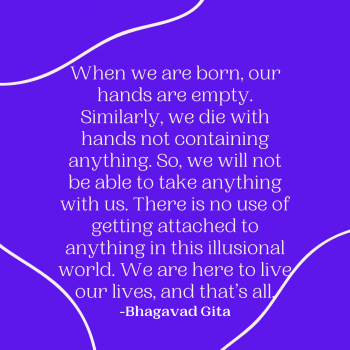
Non-attachment is another central theme in the Gita. The purpose of the practice of non-attachment is to avoid unnecessary suffering.
For example, let’s say a child wanted a bowl of Honey Nut Cheerios for breakfast. He actively goes into the kitchen but finds an empty box of Cheerios in the cupboard. This child experiences the emotion of disappointment, which is a harmless vibration in the body. Suffering occurs when he experiences disappointment and makes that mean there is nothing to eat that he likes, now he will starve, the day is ruined, and that no one cares about him because if they did, they would have bought more Cheerios.
On the flip side, this same circumstance could have played out as follows. The boy wants Cheerios. He actively goes into the kitchen to get some. He discovers the box is empty. He is disappointed for a moment. Then he looks for something else to eat while letting his mom know they need to get more Cheerios the next time they go to the store.
Each example had the same uncontrollable circumstance. The only difference was how attached the boy was to the outcome of his efforts. Attaching false beliefs to an unchangeable circumstance has the potential to cause unnecessary suffering.
The Purpose of Taking Action
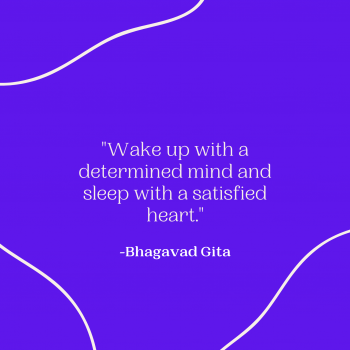
Desired results come from taking massive action until you get the outcome you want. People are not more successful because they have more capabilities. They reach success because they are more willing to act. Setting a goal inevitably will come with obstacles to overcome. Achieving a desired result is a process of failing, learning, moving on (unattached), and then repeating. Or, as the Gita suggests, successful people gain success because they remain unattached to the fruits of their efforts. They were willing to fail as many times as it took to reach their goal without making it mean anything about their efforts.
Taking action also is a process of anticipating obstacles. Then one must be willing to fail a million times until you find a solution. Some people take action once. Fail. Then never jump back on the horse. We would never have learned to walk (or ski) if this had been how we responded to failed attempts.
Navigating Blogging Obstacles
Now, starting this blog may seem like a small feat to some. For me, it was a massive undertaking. I have always held the belief that I am “not good at technology.” I have since changed this belief to “I am learning about technology.” I knew one obstacle I would have to overcome would be to learn about the in’s and outs of starting a blog. I learned about WordPress, landing pages, widgets, menu pages, email lists, content design, traffic funnels, market strategies, keyword searches, readability ratings, and page links. I also learned about blog content, niches, formatting, resizing pictures, page layout features.
I could list several other things, but I’ll spare you. The point is, I had to learn a lot. Almost all of these things I failed at the first time before figuring them out the second, third, or fourth time. And I am still learning. I also did not make these failed attempts mean anything negative about my capabilities. My brain usually throws a “You’ll never figure this out” thought out there. I simply tell my mind, “I am learning to figure it out.” Then I apply what I learned and move on.
A second obstacle I had to overcome was a long-held belief about myself. I used to think I didn’t have anything to say that others would find useful. I have since changed this belief to “I have acquired knowledge that some people may find useful.” This does not mean that I no longer doubt myself. Now, I have a new belief to power me through when I experience uncertainty. If I had not changed this old view of myself, I would have missed out on a passion that brings me great joy and meaning.
The Fear Factor
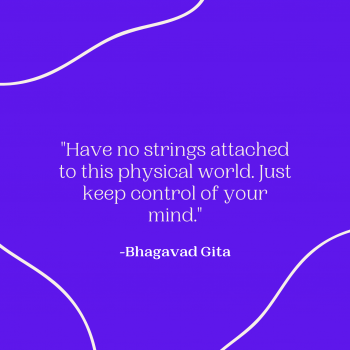
One reason why someone chooses not to live a life of Dharma is that they are attached to the outcome of failure. The problem is not failure itself. But instead, what the individual makes failure mean.
Failure is a necessary element when starting anything new. It takes an immense amount of courage to enter the unknown. Courage does not always feel very good. Your brain will most likely reject courage. The brain’s aversion to courage is simply a direct result of the evolution of our species.
The Brain’s Thoughts On Fear
The brain evolved to seek pleasure and avoid pain. The desire for pleasure used to be the driving force of survival of our species. The brain needed to learn how to maximize beneficial things in the environment and minimize contact with harmful things. Humans had to have a reason to leave the safety of their cave. That reason was to seek pleasure.
We as humans have evolved, but our brains still want to keep us safe in the cave. Doing something new doesn’t always feel very good in the beginning. Therefore, your mind will attempt to make up any excuse to dodge new tasks and avoid pain.
Pleasure at this stage is also sparse. The brain won’t always be motivated to jump on board. My mind is much more willing to pour a drink on a Friday evening than it is to work on my blog. I use my commitment to my blog and my knowledge of what will lead to the results I want to overcome my brain’s urge to let loose. This does not mean that I don’t still let loose. But now, I consciously decide when to indulge and when to work on my goals, rather than let my urges determine my actions.
The road to success requires staying committed to what you hope to achieve regardless of what your mind attempts to argue. This process may not feel very pleasurable in the moment; however, the long-term benefits include greater confidence, new capabilities, and movement toward the direction of your purpose.
Concluding Factor

Ultimately, the worst that can happen on the path of success is a feeling. We get to decide what we want to make any emotion mean. Being courageously committed to a new goal will inevitably lead to experiencing failure. It is important to remember that failure is just feedback. Apply what is useful and forget the rest. Eventually, new capabilities develop from the process of trial and error. Then one day, your journey will inexplicably end with the obtainment of your goal.
The Gita is a useful source that can provide direction for your life. I recommend further exploration of this text to increase your self-knowledge. You can reveal your passions if you take the time to know yourself better and explore what brings you joy. The Gita also addresses aspects of the mind that can either hold us back or move us toward our goals or passions. The central theme of taking the right action while remaining unattached to those efforts is no small task; however, this is one secret to achieving significant, maybe even unbelievable results for your life.
Contemplation Points
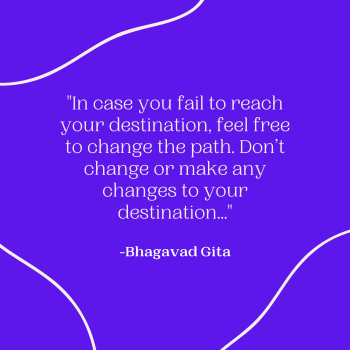
1) List three things that bring joy to your life. Do you do these things each day? Are there things you can cut back on or stop doing to make time for these things?
For example, I have significantly cut back on watching Netflix. If I do, I watch shows when I am riding my exercise bike. Moving my body is one thing that brings me joy. If I want to catch up on a series, I will do it then. I also get up at 5:15 instead of 6:00 am. The extra time allows me to practice my morning breathing routine. Now, there have been mornings when I have slept past my alarm or failed to get up. It happens much less often now because I know the benefits of following through with my morning routine. But when it does happen, I don’t make my failed efforts mean I am terrible at life, or that I am incapable of having a morning routine. Instead, I inquire about why I did not get up. Make the proper adjustments. Then plan to wake up for my practice the next morning.
2) Practice failing five times per/week. Collect each failure like a badge of honor. Consider your failed efforts to be like a workout that makes you stronger.
I attempted to collect five defeats last week. I took way more risks and followed through with things I wanted to try because I wanted to see if I could fail. So go have some fun with failure rather than reject it.
3) What meaning have you attached to failure? Is this preventing you from doing new things? Can you change your belief about failure and give it a new meaning?
For example, I shifted the term failure to mean learning. “I am learning” feels more empowering to me than “I am failing.”







